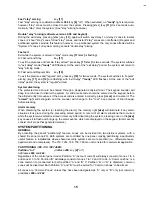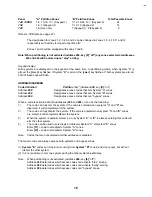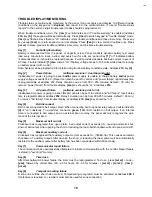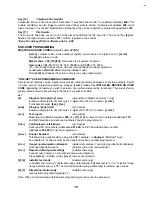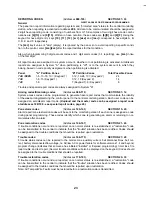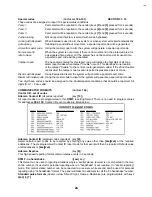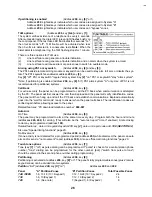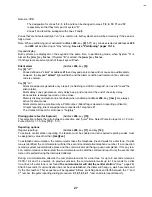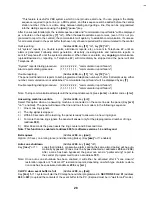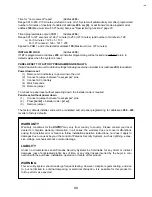
*This feature is useful for PBX systems, which do not provide a dial tone. You can program the dialing
sequence required to get a line on a PBX system, and this sequence will be added before the central
station number. If there is a time delay between dialing and getting a line, this can be programmed
into the dialing sequence using the [
MEM
] ("pause") key.
After 8 unsuccessful attempts, the redial sequence ends and "communicator report failure" will be displayed
as a trouble on the keypad (key [7] "on"). When the next reportable event occurs, (even if it is not pro-
grammed to report to the central), the communicator will again try to establish communication. If success-
ful, all events stored in the event buffer that have not yet been reported will be communicated to the central.
Split reporting
(Address 206, key [11] "on", key [12] "off")
All "system" reports (i.e. trouble reports, arm/disarm reports, etc.) are sent to Telephone #2, until an
alarm is generated. Following alarm generation, all activity, including alarm and restoration reports, is
sent to Telephone #1 until the system is disarmed. When there is an alarm, any ongoing communication
(upload/download or reporting to Telephone #2) will immediately be stopped and the panel will dial
Telephone #1.
"System" reports dialing procedure:
(2,2,2,2,2,2,2,2, "communicator report failure")
Alarm reports dialing procedure:
(1,1,1,1,1,1,1,1, "communicator report failure")
Double reporting
(Address 206, key [11] "on", key [12] "on")
The panel will transmit all reports to both programmed telephone numbers. If, after 8 attempts using either
number, communication is not established, "communicator report failure" will be displayed by key [7].
Double reporting dialing procedure:
(2,2,2,2,2,2,2,2, "communicator report failure")
(1,1,1,1,1,1,1,1, "communicator report failure")
Note: To stop communication attempts until the next reportable event, press [
ENTER
] + installer code + [
STAY
].
Answering machine override
(Address 206, key [
BYP
])
Select this option when an answering machine is connected on the same line as the panel. (Key [
BYP
]
"on" = enabled). The panel will answer the line and look for a modem in the following sequence:
1)
One or two ring signals.
2)
The ring signal is stopped.
3)
Within 60 seconds of the last ring, the panel is ready to answer on a new ring signal.
4)
For more than two ring signals, the panel will answer only for the preprogrammed number of rings
(address 000).
5)
After 60 seconds the panel resets the ring counter and 60 second timer.
Note: This function is enabled at address 000 for software versions 1.4 and beyond.
Bell squawk
(Address 206, key [
MEM
])
Option: (0.5 sec.) on arming (once) and disarming (twice). (Key [
MEM
] "on" = enabled)
Auto zone shutdown
(Address 206, key [
TRBL
] "on")
Key [
TRBL
] "on" =
zones that initiate 4 consecutive alarms during the same armed period will be auto-
matically bypassed. (Zones must be bypass-enabled at addresses 236 and 238.)
After a zone has been bypassed, the panel can send a "partial arming" report to
the central (if programmed to do so at address 187).
Note: Once auto zone shutdown has been enabled, it will either be activated after 4 "zone closure"
restoration reports or 4 "bell cut-off " restoration reports, depending on which type of alarm restora-
tion code has been activated at address 208, key [
BYP
].
Call PC when event buffer is full
(Address 208, key [2
ND
])
Key [2
ND
] "on" = system will dial the PC telephone number programmed in SECTION 00 and 01 (address
060 to 067) to upload the contents of the event buffer to the PC. (Espload must be in "wait for call" mode).
28
IM8


